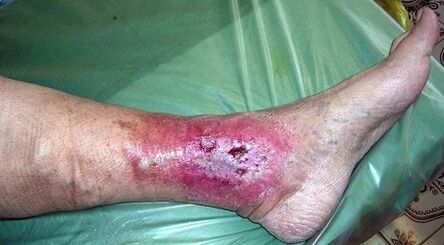The varicose vessels of the lower extremities are an extremely urgent problem of modernity.To find out why the disease develops and how it can be healed, it is necessary to remember the anatomical characteristics of the circulatory system structure.
What are the varicose veins of the surface veins?
The main task of the venous leg system is to transport blood from the bottom up.To do this, there are valves in their veins - they direct the blood from legs to heart.
In addition, for proper operation, the vessels are divided into 3 groups:
- Superficial.They are located close to the skin and are more often subjected to varicose expansion.
- Deep.This group of vessels runs between muscle fibers.
- Other.Its task is to ensure the connection between the superficial and deep vessels.
Why do the varicose veins of the surface develop?

Ships can increase the diameter several times over time.
This process is affected by factors such as:
- Heredity.But only the genetic background is not enough for the development of the pathology.A responsible attitude towards disease prevention is able to prevent the development of varicose veins.
- Pregnancy, delivery, menopause or hormonal drugs.Often the formation of disease in women is the basis of these causes.
- Passive lifestyle.The less the calf muscles work, the greater the chance that the varicose disease develops.
How do the varicose veins of the surface veins manifest themselves?
Symptoms of the disease can be divided external (cosmetic) and basic.The external manifestations of surface veins varicose veins include nodes of varicose veins, legs rolled into the legs, a change in the skin (especially pigmentation and dryness in the ankle region - the skin here is sensitive and thin).
The main symptoms include:
- Pain and sensations of “heavy legs”
- Swelling.Sometimes the swelling is so pronounced that the usual size of the shoes becomes small.
- Feet with itching varicose veins.
- Vienna in the leg pulsa.
What could be the dangerous varicose veins of the surface veins?

The danger is not in the disease itself, but in its complications.
With the varicose veins, the chances of developing blood clots in the vessels increases several times.If the blood clot has formed in the veins of the legs and move away from the venous wall, then with a blood flow, it can easily enter the vessels of the lungs.
Blocking the pulmonary artery usually causes death.In addition, trophic ulcers are often formed in the ankles.Infection infection in this case leads to unpleasant consequences (suppuration, sepsis).
How to treat the veins of the veins of the surface veins?
Extended veins are not subject to restoration.To establish blood circulation, the removal of radical vessels is required.Fortunately, today it is not difficult to remove the veins from the expanded surface.
For these purposes, laser energy and radio frequency are used.In the removal process, the patient remains conscious and feels nothing (this is possible through the use of local anesthesia).Also, immediately after operation, you can go home and these methods leave no traces of the procedure.
In addition to surgical intervention, good varicose veins, sclerotherapy, cream and leg ointments, as well as traditional drug recipes, are additionally used.Among these methods, it is worth highlighting sclerotherapy - as an innovative way to combat the initial varicose veins.With it, it is possible to act in small varicose veins and capillaries.
The surface veins varicose veins can and should be avoided.To do this, move actively, eat correctly and not forget to visit a phlegologist twice a year for a planned exam and diagnosis of the state of the leg vessels.























